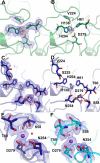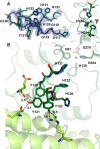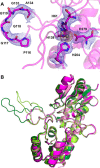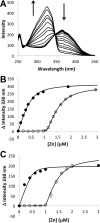Mechanisms of zinc binding to the solute-binding protein AztC and transfer from the metallochaperone AztD
- PMID: 28887302
- PMCID: PMC5655524
- DOI: 10.1074/jbc.M117.804799
Mechanisms of zinc binding to the solute-binding protein AztC and transfer from the metallochaperone AztD
Abstract
Bacteria can acquire the essential metal zinc from extremely zinc-limited environments by using ATP-binding cassette (ABC) transporters. These transporters are critical virulence factors, relying on specific and high-affinity binding of zinc by a periplasmic solute-binding protein (SBP). As such, the mechanisms of zinc binding and release among bacterial SBPs are of considerable interest as antibacterial drug targets. Zinc SBPs are characterized by a flexible loop near the high-affinity zinc-binding site. The function of this structure is not always clear, and its flexibility has thus far prevented structural characterization by X-ray crystallography. Here, we present intact structures for the zinc-specific SBP AztC from the bacterium Paracoccus denitrificans in the zinc-bound and apo-states. A comparison of these structures revealed that zinc loss prompts significant structural rearrangements, mediated by the formation of a sodium-binding site in the apo-structure. We further show that the AztC flexible loop has no impact on zinc-binding affinity, stoichiometry, or protein structure, yet is essential for zinc transfer from the metallochaperone AztD. We also found that 3 His residues in the loop appear to temporarily coordinate zinc and then convey it to the high-affinity binding site. Thus, mutation of any of these residues to Ala abrogated zinc transfer from AztD. Our structural and mechanistic findings conclusively identify a role for the AztC flexible loop in zinc acquisition from the metallochaperone AztD, yielding critical insights into metal binding by AztC from both solution and AztD. These proteins are highly conserved in human pathogens, making this work potentially useful for the development of novel antibiotics.
Keywords: ABC transporter; chap; chaperone; crystal structure; metal homeostasis; transport metal; zinc.
© 2017 by The American Society for Biochemistry and Molecular Biology, Inc.
Conflict of interest statement
The content is solely the responsibility of the authors and does not necessarily represent the official views of the National Institutes of Health
Figures










References
MeSH terms
Substances
Associated data
- Actions
- Actions
- Actions
Grants and funding
LinkOut - more resources
Full Text Sources
Other Literature Sources
Research Materials

